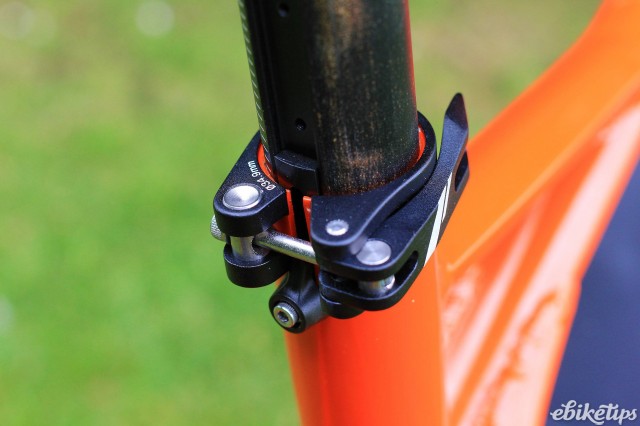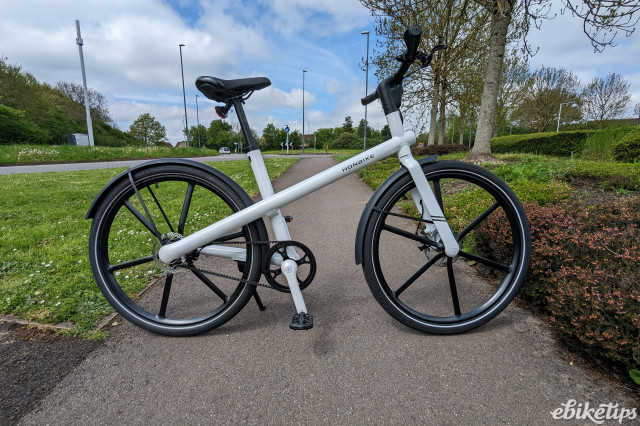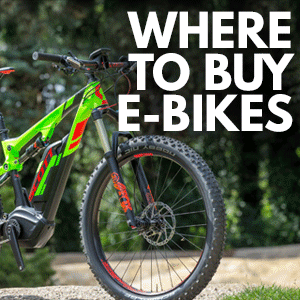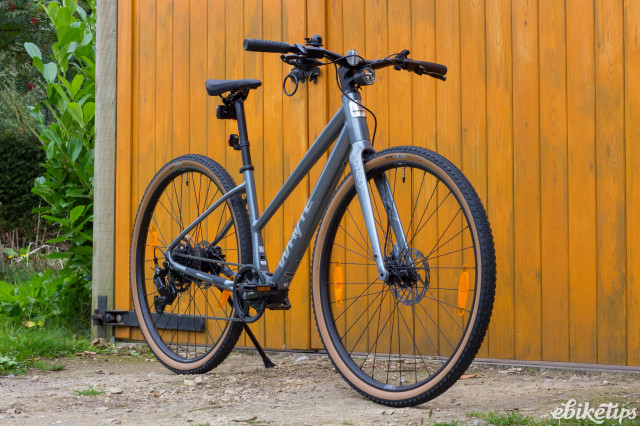Review: Orbea Wild 20
Overview
- Fun to ride on all terrain
- High quality motor system
- Seatpost system works pretty well
- Tyres aren't good in gloop and mulch
- Spec is decent rather than great value
Orbea's Wild is a fully trail-capable hardtail that's fun to ride and well set-up for all-day trail bashing with Bosch's top-line motor and biggest battery pack. The spec is decent rather than great for the money, and the tyres aren't the best choice for grimy UK riding, but it's a well-balanced, high-quality machine for your off-road adventures.
There's a few of the current trends evident in the Wild 20. For a start it's using the 27.5+ wheel standard, with a 40mm rim and a 3" Maxxis tyre. Those big tyres offer good cushioning and traction without having to make the jump to wider fat bike standards, although the Wild does feature the newer 148mm rear / 110mm front Boost spacing. The only real downside to 27.5+ is weight, but when you have a motor helping you out that's not really an issue. Up front you get further damping courtesy of a 120mm Fox 32 fork with a three position damping lever which allows you to tune the response of the fork on the fly.
At present the Wild range uses a single hardtail frame – a full suspension model is coming – and three levels of build. The Wild 20 is the middle spec and retails in the UK at £3,099. You'll still see that bike in shops, but a running change to the Wild range sees the bike rebranded as the Wild 20 LR, with a slightly different spec. The fork is upgraded to a Fox 34 and Kenda tyres replace the Maxxis Chronicle ones we tested; you get a wider 11-46 cassette at the rear too. The new build is a bit pricier, at £3,299.
Orbea have gone for a fairly performance-oriented geometry from the hydroformed alloy frame. The Wild isn't quite as long or relaxed at the front as Orbea's Loki 27+ hardtail but it's still very much in trail bike territory where in the past electric mountain bikes have been more leisure-oriented in terms of the ride position. That's a trend we've been seeing from many manufacturers, with both Trek and Giant updating their 2017 e-bike ranges with a more aggressive position.
You don't get a remote dropper 'post on this build of the bike (the more expensive Wild 10 gets one) but the bike does get Orbea's Digit seatpost system which allows you to set a top and bottom limit so it's easy to drop your seat down or pick it up. You can spec a Rockshox Reverb Stealth dropper 'post for an extra £239.
> Where to buy an Orbea e-bike
Orbea use the Bosch Performance Line CX motor, and it's a favourite at ebiketips for its well-balanced performance. Bosch's top capacity 500Wh battery is fitted too. You get the centrally mounted Intuvia display, along with the standard remote by the left hand grip. The motor is angled upwards in the frame for better ground clearance and there's an alloy bash guard to protect it from hits. You get better pedal clearance too thanks to the 152mm cranks; that's a lot shorter than a standard setups; 170mm cranks are available as an £16 cost option.
The drivetrain is 11-speed Shimano XT with matching hydraulic brakes with an 11-42 cassette to help you tackle pretty much anything. Finishing kit is a mix of Orbea own-brand, Race Face and FSA gear.
Dave says: let's deal with the ride first. The Wild 20 rides like a proper trail hardtail, and it's lots of fun. Geometry-wise it isn't the longest – especially compared to the Mondraker e-Prime R+ we also have at the moment but it's still very confident on the steeper downhill stuff and very engaging to ride. The Maxxis Chronicle tyres are excellent on hardpack and rocky surfaces, with pretty encouraging levels of grip and good cushioning from the 3” carcass. When things get gloopy they're not as good, and they don't bite through loose leaf matter so they can get a bit sketchy on muclhy Autumn trails. Overall they're not bad, but I'd prefer something a little more aggressive for UK conditions.
I found the Wild 20 to be most at home on natural trails in open country, with the big tyres rolling well and the motor giving you more time to admire the views on the climbs. When things get technical it's still a very capable machine. It doesn't have a dropper seatpost but the Digit seatpost system works well. It's easy to set up and you have two positions – up and down – that you can easily find. In wet and gritty conditions it often took a rinse of the seatpost with the hydration bladder to persuade the seatpost to budge, but it's a decent upgrade over a standard seatpost and quick release clamp.
I genuinely didn't notice the 152mm cranks, save for the fact that they do reduce the amount of pedal strike you get on the rocky stuff. When you're making use of the motor you don't really need the leverage of the long cranks. The idea is that the shorter cranks will also encourage you to spin at a higher cadence which matches up better with the way the motor works. I didn't notice that my legs were spinning faster, and nor did I notice that the motor input felt more natural than on bikes with longer cranks. I guess the bottom line is that I didn't really notice, at all, but your pedals are about 20mm higher than they would normally be, meaning you hit them on less stuff. So that's a win. The Shimano XT drivetrain did nothing of note, other than work. The 11-42 cassette is plenty for pretty much anything short of a cliff if you're getting motor assistance too. The Shimano brakes were pretty faultless too, offering bags of braking power in all conditions.
At Bike Park Wales the Orbea excelled on the blue runs, making short work of the berms and the smoother trail surfaces. Once things progressed to red – especially on the rockier sections of trail – it was slightly less assured, but still gave a good account of itself. On slippery roots it needs a firm hand: once you get that heavy frame and big tyres heading sideways, they tend to keep going, and I found myself forging a new trail on a couple of occasions after hitting a shiny root and not being able to correct. That's a more general issue to do with weight though, it's not specific to this bike. I took the Wild 20 off a few smaller drop-offs (well, big for me!) and it was composed and neutral. The weight is noticeable when you land, but it's not really any more difficult to control than a normal trail hardtail. The 120mm Fox 32 fork was good, though at times on the more technical terrain and bigger landings it felt a little under-forked. Stiffness and steering response were both fine, though. The bigger-stanchion Fox forks feel more solid but I didn't have any real issues.
Range-wise you can do a lot of riding on the Wild 20, if you're easy on the juice. I've taken it out for a hilly 40km loop and had enough battery left to engage the hyperdrive on the last climb of the day. 50Km off-road rides are possible if you're willing to do some of the work yourself. On the flip side of the coin I spent a happy day at Bike Park Wales basically using the motor as an uplift and mostly sticking to Sport and Turbo modes, with a bit of Tour on the easy stuff. Even then I managed to get 30km out of the battery, and that's half climbing and half descending; there's not much flat riding at a downhill-oriented trail centre.
If you want to extend you range you can always throw a charger in your trail pack – Bosch do a compact one now, as well – and ask nicely at the cafe when you order your lunch. An hour or two of extra juice will give you plenty of extra riding under power. As always, you need to make intelligent choices about power mode and route choice. Running out of battery isn't generally any fun, and this Orbea is no exception. You can get it home, but it won't be at any great pace.
Up above three grand you're getting into territory where you can bag yourself a pretty decent full suspension bike, and you'll need to make a call on whether a hardtail is going to be best for the riding you do. It's worth bearing in mind when you do that some of the usual downsides of a full-suspension platform aren't really that relevant when you're talking about an e-bike. Hardtails are generally lighter and more responsive out of the saddle so they're at an advantage on a climb; many rear shocks will have a lockout for climbing because of that. Weight's less of an issue on an e-bike though. In fact, where the extra weight of the bike can make landings on a hardtail feel harsh, the extra sprung mass in the middle of a full-suspension e-bike can actually improve the feel of the suspension. When you've got a motor helping you your technique for climbing is different too: there's less need to attack the steep stuff so you can get up pretty much anything seated.
That's not to say everyone should go out and buy a full-suspension bike: you might prefer the simplicity of a hardtail, and the plus-sized tyres do make a decent job of ironing out the smaller stuff, expecially if you run them tubeless. If a hardtail is what you're after then there's lots to like about the Wild 20. It's a well-considered bike that eats up the trails, and it's nicely specced for the money: not a bargain, but a solid buy.



































